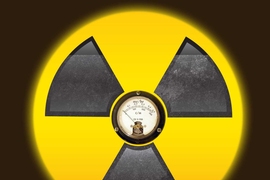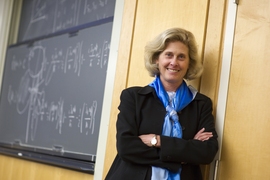Not long after midnight on April 26, 1986, the world’s worst nuclear power accident began. Workers were conducting a test at the Chernobyl Nuclear Power Plant in the Ukraine when their operations spun out of control. Unthinkably, the core of the plant’s reactor No. 4 exploded, first blowing off its giant concrete lid, then letting a massive stream of radiation into the air.
Notoriously, the Soviet Union kept news of the disaster quiet for a couple of days. By the time the outside world knew about it, 148 men who had been on the Chernobyl site — firefighters and other workers — were already being treated in the special radiation unit of a Moscow hospital. And that was just one sliver of the population that wound up seeking medical care after Chernobyl.
By the end of the summer of 1986, Moscow hospitals alone had treated about 15,000 people exposed to Chernobyl radiation. The Soviet republics of Ukraine and Belarus combined to treat about 40,000 patients in hospitals due to radiation exposure in the same period of time; in Belarus, about half were children.
And while 120,000 residents were hastily evacuated from the “Zone of Alienation” around Chernobyl, about 600,000 emergency workers eventually went into the area, trying to seal the reactor and make the area safe again. About 31,000 soldiers camped out near the reactor, where radioactivity reached about 1,000 times the normal levels within a week, and contaminated the drinking water.
Which leads to the question: How bad was Chernobyl? A 2006 United Nations report contends Chernobyl caused 54 deaths. But MIT Professor Kate Brown, for one, is skeptical about that figure. As a historian of science who has written extensively about both the Soviet Union and nuclear technology, she decided to explore the issue at length.
The result is her new book, “Manual for Survival: A Chernobyl Guide to the Future,” published this month by W.W. Norton and Co. In it, Brown brings new research to bear on the issue: She is the first historian to examine certain regional archives where the medical response to Chernobyl was most extensively chronicled, and has found reports and documents casting new light on the story.
Brown does not pinpoint a death-toll number herself. Instead, through her archival research and on-the-ground reporting, she examines the full range of ways radiation has affected residents throughout the region, while explaining how Soviet politics helped limit our knowledge of the incident.
“I wrote this book so it’s something we take a look at more seriously,” says Brown, a professor in MIT’s Program in Science, Technology, and Society.
Lying to themselves
To see how the effects of Chernobyl could be much more widespread than previously acknowledged, consider a pattern Brown observed from her archival work: Scientists and officials at the local and regional levels examined the effects of Chernobyl on people quite extensively, even performing controlled studies and other robust techniques, but other Soviet officials minimized the evidence of major health consequences.
“Part of the problem is the Soviets lied to themselves,” says Brown. “On the ground it [the impact] was very clear, but at higher levels, there were ministers whose job was to report good health.” Soviet officials, Brown adds, would “massage the numbers” as the data ascended in the state bureaucracy.
“Everybody was making the record look better by the time it go to Moscow,” Brown says. “And I can show that.”
Then too, the effects of Chernobyl’s radiation have been diffuse. As Brown discovered, 298 workers at a wool factory in the city of Chernihiv, about 50 miles from Chernobyl, were given “liquidator status” due to their health problems. This is the same designation applied to emergency personnel working at the Chernobyl site itself.
Why were the wool workers so exposed to radiation? As Brown found after investigating the Chernihiv wool factory itself, Soviet authorities had workers kill livestock from the Zone of Alienation — and then send their useable parts for processing. The wool factory workers had become sick because they were dealing with wool from highly contaminated sheep. Such scenarios may have been significantly overlooked in some Chernobyl assessments.
A significant section of “Manual for Survival” — the title comes from some safety instructions written for local residents — also explores the accident’s effects on the region’s agricultural economy. In Belarus, one-third of milk and one-fifth of meat was too contaminated to use in 1987, according to the official in charge of food production in the state, and levels became worse the following year. At the same time, in the Ukraine, between 30 and 90 percent of milk in “clean” areas was judged too contaminated to drink.
As part of her efforts to study Chernobyl’s effects in person, Brown also ventured into the forests and marshes near Chernobyl, accompanying American and Finnish scientists — who are among the few to have extensively studied the area’s wildlife in the field. They have found, among other things, the decimation of parts of the ecosystem, including dramatically fewer pollinators (such as bees) in higher-radiation places, and thus radically reduced numbers of fruit trees and shrubs. Brown also directly addresses scientific disagreements over such findings, while noting that some of the most negative conclusions about the regional ecosystems have stemmed from extensive on-the-ground investigations of it.
Additionally, disputes over the effects of Chernobyl also rumble on because, as Brown acknowledges, it is “easy to deny” that any one occurence of cancer is due to radiation exposure. As Brown notes in the book, “a correlation does not prove a connection,” despite increased rates of cancer and other illnesses in the region.
Still, in “Manual for Survival,” Brown does suggest that the higher end of existing death estimates seems plausible. The Ukrainian state pays benefits to about 35,000 people whose spouses apparently died from Chernobyl-caused illnesses. Some scientists have told her they think 150,000 deaths is a more likely baseline for the Ukraine alone. (There are no official or unofficial counts for Belarus and western Russia.)
Chernobyl: This past isn’t even past
Due to the long-term nature of some forms of radiation, Chernobyl’s effects continue today — to an extent that is also under-studied. In the book’s epilogue, Brown visits a forest in the Ukraine where people pick blueberries for export, with each batch being tested for radiation. However, Brown observed, bundles of blueberries over the accepted radiation limit are not necessarily discarded. Instead, berries from those lots are mixed in with cleaner blueberries, so each remixed batch as a whole falls under the regulatory limit. People outside the Ukraine, she writes, “may wake to a breakfast of Chernobyl blueberries” without knowing it.
Brown emphasizes that her goal is not primarily to alarm readers, but to push research forward. She says she would like her audience — general readers, undergraduates, scientists — to think deeply about how apparently settled science may sometimes rely on contingent conclusions developed in particular political circumstances.
“I would like scientists to know a bit more about the history behind the science,” Brown says.
Other scholars say “Manual for Survival” is an important contribution to our understanding of Chernobyl. J.R. McNeill, a historian at Georgetown University, says Brown has shed new light on Chernobyl by illuminating “decades of official efforts to suppress its grim truths.” Alison MacFarlane, director of the Institute for International Science and Technology Policy at George Washington University, and Former director of the Nuclear Regulatory Commission, says the book effectively “uncovers the devastating effects” of Chernobyl.
For her part, Brown says one additional aim in writing the book was to help us remind ourselves that our inventions and devices are fallible. We need to be vigilant to avoid future disasters along the lines of Chernobyl.
“I think it could be a guide to the future if we’re not a little bit more thoughtful, and a little more transparent” than the Soviet officials were, Brown says.









